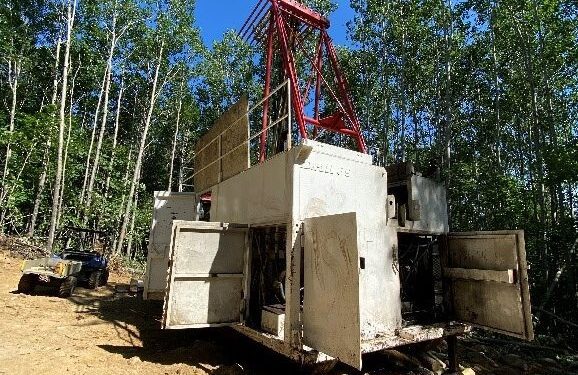New Age Metals Inc. (TSXV: NAM; OTCQB: NMTLF); FSE: P7J.F) has identified high-grade results from its metallurgical study programme at its 100% owned River Valley Palladium Project,100 km east of the City of Sudbury, Ontario.
This study is being carried out as a key component of the ongoing Pre-Feasibility Study of the River Valley Palladium Project.
Metallurgical Sample Assay Programme
Further to the announcement dated November 10, 2021, NAM has now received metre-by-metre assay results from SGS for all four of the metallurgical holes drilled at River Valley in 2021
Four short diamond holes were drilled inside the River Valley Deposit, one each at the Dana North, Dana South, Lismer North and Lismer Ridge Mineralised Zones.
These HQ-size drill holes were planned to validate mineralised zone models and maximise recovery of fresh mineralised sample material for the mineral processing and metallurgical testwork studies. The Dana Zones and the Lismer Zones were selected for study, because they are the most assessible and the best understood of the ten known palladium mineralised zones and therefore the most probable starting location for any potential mining operation at River Valley.
The four drill holes intersected palladium mineralisation in gabbroic rocks of the host Breccia Unit for almost the entire length of each hole. The palladium mineralised intersections are summarized below.
The Dana North Zone hole (DN-21-01m) was drilled for 201 m obliquely down-dip, parallel to the metallurgical hole drilled in 2012. Drill hole DN-21-01m intersected 2.08 g/t 3E and 0.12% Cu (or $117/t NSR) over 141.5 m from 0.5 m downhole from surface, including 2.24 g/t 3E and 0.13% Cu (or $126/t NSR) over 124.5 m, and 1.21 g/t 3E and 0.09% Cu (or $68/t NSR) over 55 m from 145 m downhole, including 1.37 g/t 3E and 0.09% Cu ($77/t NSR) over 45 m.
The relatively higher-grade interval from near-surface is not surprising, given that this hole was collared on some of the highest-grade material ever sampled historically at River Valley. This drill hole also ended in mineralisation.
The Dana South Zone hole (DS-21-01m) was drilled for 200 m obliquely down-dip, in contrast to the vertical hole drilled in 2012. Drill hole DS-21-01m intersected 2.74 g/t 3E and 0.20 % Cu over 11 m from surface, and 3.00 g/t 3E and 0.15% Cu (or $166/t NSR) over 66 m from 111 m downhole, including 3.48 g/t 3E and 0.17% Cu over 47 m (or $192/t NSR)\.
These are the highest grade intersects in the four drill holes, consistent with Dana South having the highest average grade of the four mineralized zones. This drill hole also ended in higher-grade mineralisation.
The Lismer North Zone hole (LN-21-01m) was drilled for 185 m obliquely down-dip. Drill hole LN-21-01m intersected 1.02 g/t 3E and 0.13% Cu (or $59/t NSR) over 23 m from 21 m downhole, 1.01 g/t 3E and 0.06% Cu (or $55/t NSR) from over 7 m from 131 m downhole, 0.99 g/t 3E, and 0.08% Cu (or $55/t NSR) over 11 m from 143 m downhole, including 1.63 g/t 3E and 0.12% Cu (or $89/t NSR) over 3.0 m from 145 m downhole, 1.61 g/t 3E and 0.06% Cu (or $87/t) over 3 m from 151 m downhole, and 2.34 g/t 3E and 0.07% Cu (or $129/t NSR) over 14 m from 162 m downhole (Table 1). Compared to the Dana North and Dana South results, the mineralisation at Lismer North appears in this drill hole to be lower grade and less continuous.
The Lismer Ridge Zone hole (LR-21-01m) m was drilled for 215 m obliquely down-dip.
This Lismer Ridge hole (LR-21-01m) intersected 1.06 g/t 3E and 0.06% Cu (or $58/t NSR) over 27 m from 6 m downhole, 0.82 g/t 3E and 0.05% Cu (or $45/t NSR) over 30 m from 130 m downhole, including 2.32 g/t 3E and 0.17% Cu (or $130/t NSR) over 4.0 m from 156 m downhole, 1.16 g/t 3E and 0.07% Cu (or $83/t NSR) over 21 m from 170 m downhole and 2.39 g/t 3E and 0.07% Cu (or $128/t NSR) over 4 m from 205 m downhole.
Unlike the other three drill holes, LR-21-01m deviated more than usual and exited the wireframed mineralised domain at 175 m downhole, but remained in mineralisation (some higher grade) for an additional 40 m till end of hole. This surprising result makes this area east-adjacent to Lismer Ridge a promising exploration target of interest.
Each of the four drill holes provided an average of approximately 1,700 kg of material for a total of 6,800 kg, plenty for: 1) extensive testwork on a composite sample from each zone plus an overall composite sample from the four zones; 2) comprehensive assaying and QEMSCAN studies to follow the main metals (Pd, Pt, Au and Cu) during the testwork; and 3) high-sensitivity assaying to assist in determining Rh recoveries.
The two Dana holes were drilled in June 2021 by Multi Drilling (Rouyn-Noranda) and the two Lismer holes in July 2021 by Jacob & Samuel Drilling Ltd. (Sudbury). After logging, each hole was sampled at 1 metre intervals. Each 1.0 metre interval was cut into equal halves with a diamond saw. Half the core was sent to SGS Canada Inc’s processing facilities in Lakefield for assay and preparation for metallurgical testwork. In total, 809 samples from the four drill holes (plus 37 “blind” certified QC samples) were assayed.
The metallurgical testwork samples were received by SGS Lakefield in June, 2021 (Dana Zones) and August, 2021 (Lismer Zones). The total weight of the samples received was 3,483 kg. Recipes for the four Lismer grade variability composites (0.5 g/t 3E, 0.8 g/t 3E, 1.0 g/t 3E and 1.3 g/t 3E) were finalised and delivered by D.E.N.M Engineering (DENM) to SGS Lakefield in late-January 2022. Recipes for Dana grade variability composites have been finalised and delivered by D.E.N.M. to SGS in late February, 2022.
For further information please visit: https://newagemetals.com/












